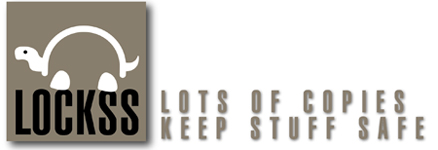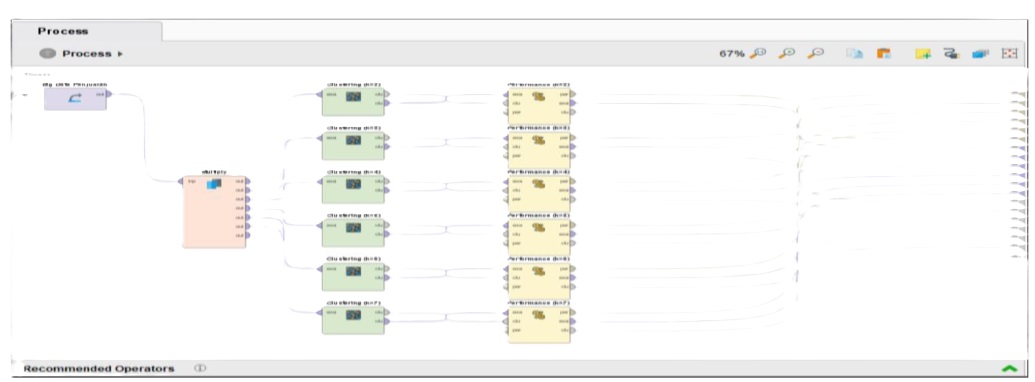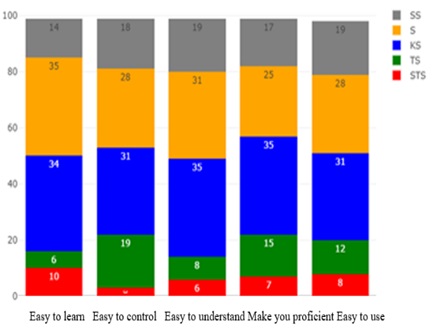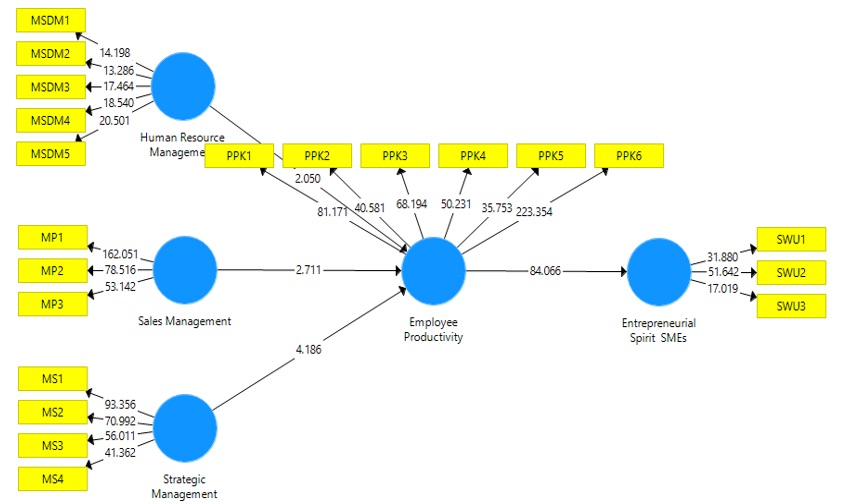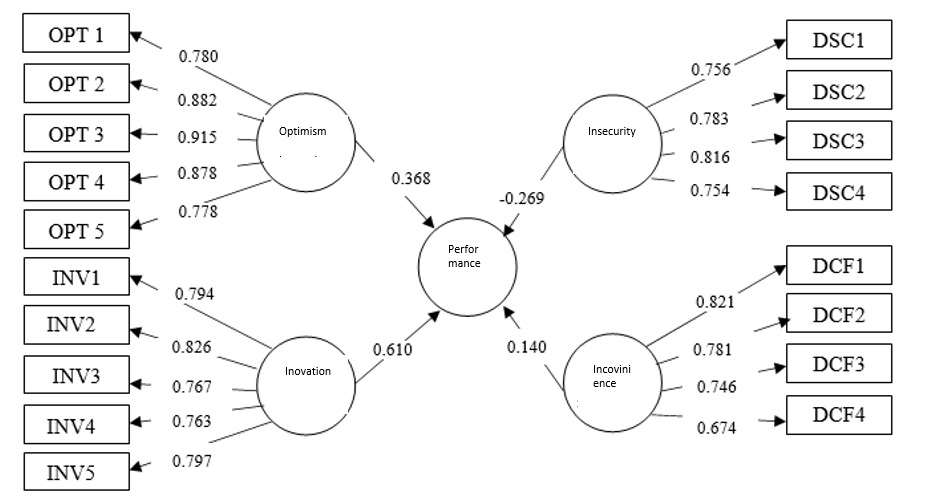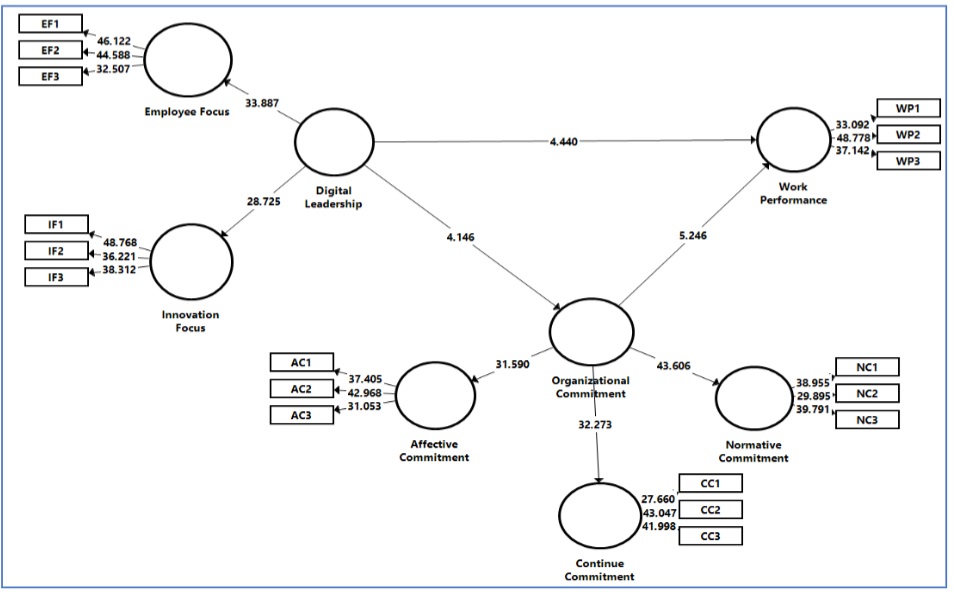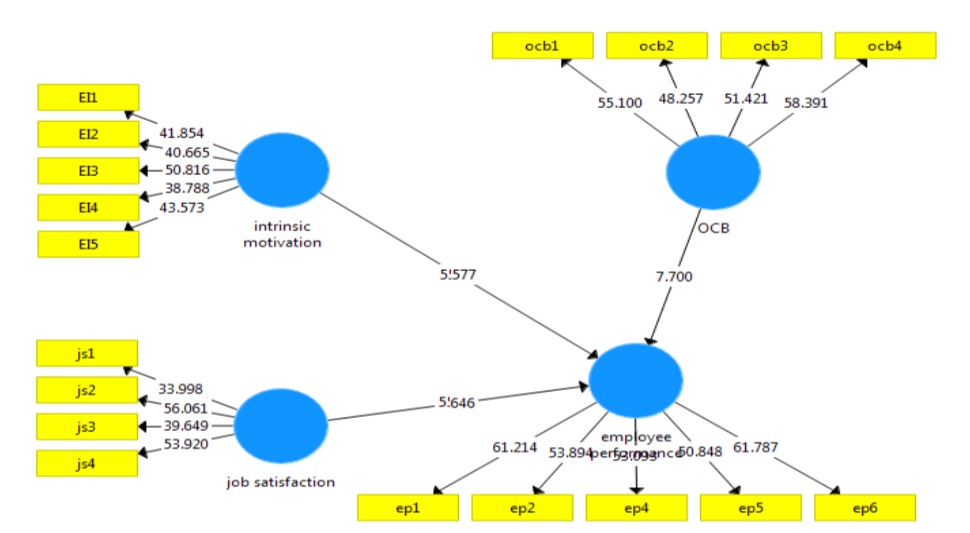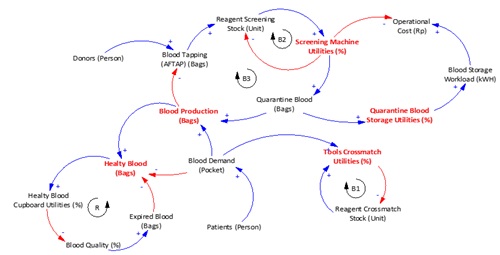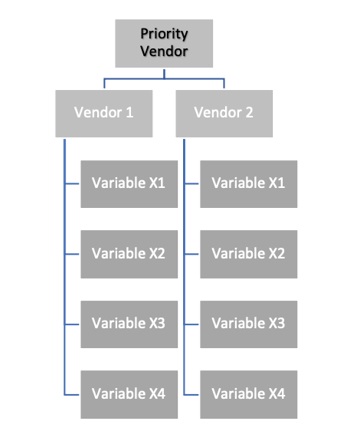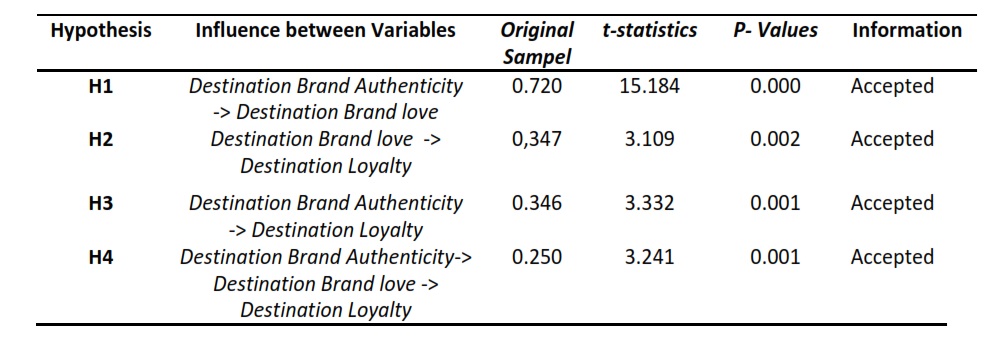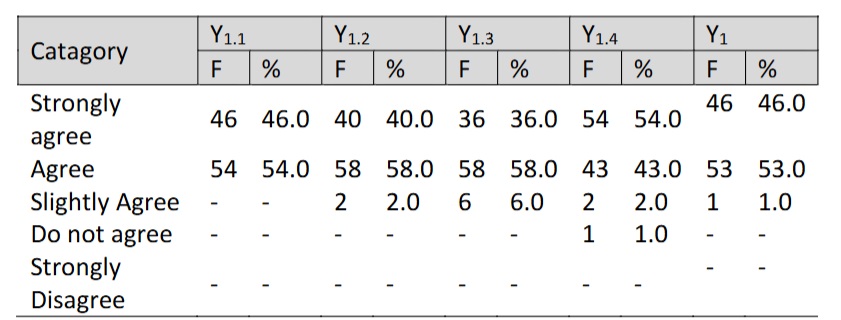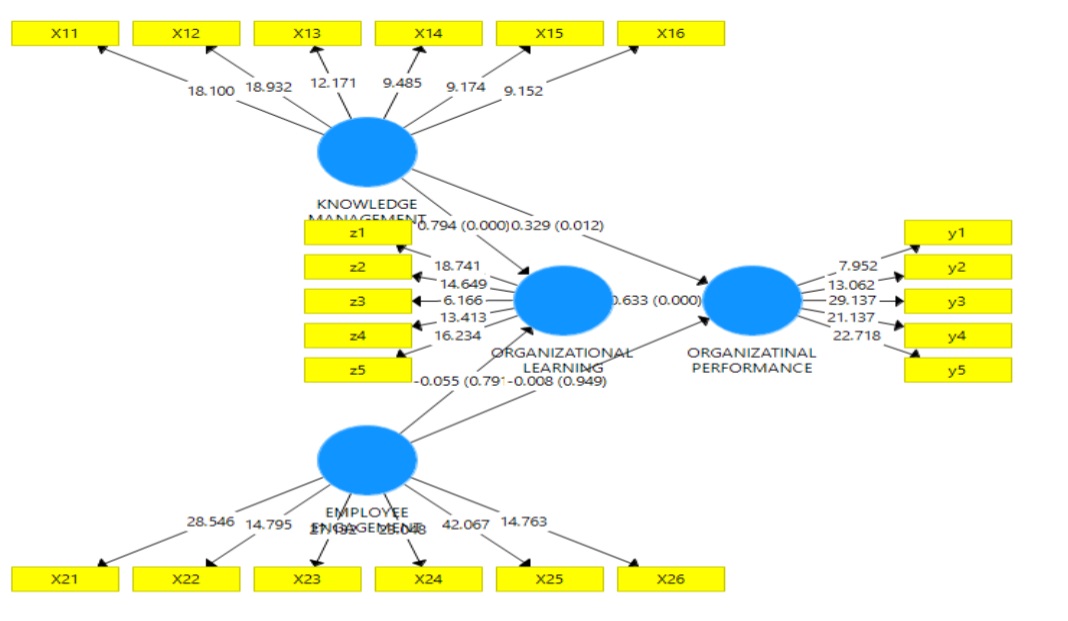HUBUNGAN ANTARA KETERAMPILAN PENJUALAN DAN KINERJA TENAGA PENJUAL DI PERUSAHAAN CAT INDONESIA
Downloads
Additional Files
Abstract
The phenomenon of the existence of a successful salesperson and does not indicate that the variables affect the salesperson's performance. The understanding is beneficial for the company to provide training focus. The purpose of this study is to test the influence of sales skills dimensions (interpersonal skill, salesmanship skill, marketing skill, company's product knowledge and competitors' product knowledge) on salesperson performance in a domestic paint company which has the potential to influence salesperson performance. The questionnaire was distributed to 57 Supervisors with samples amounting to 268 salespersons form 348 population. The method is linear regression analysis through SPSS Statistik 26th edition software. This analysis was conducted to test the influence of sales skills dimensions on salesperson performance. Based on the questionnaire, it is evident that salesmanship and interpersonal skills have a significant influence on salesperson performance. On the contrary, the remaining three dimensions were found to have no influence on salesperson performance.
Abstrak
Fenomena adanya tenaga penjual yang sukses dan yang gagal menunjukkan bahwa terdapat variabel yang memengaruhi kinerja tenaga penjual. Pemahaman ini bermanfaat bagi perusahaan untuk memberikan fokus pelatihan. Penelitian ini ditujukan untuk menguji pengaruh dimensi keterampilan penjualan yakni: keterampilan interpersonal, keterampilan keahlian menjual, keterampilan pemasaran, kemampuan pengetahuan produk perusahaan dan kemampuan pengetahuan produk pesaing terhadap kinerja tenaga penjual di sebuah perusahaan cat nasional yang memiliki potensi untuk memengaruhi kinerja tenaga penjual. Kuesioner didistribusikan kepada 57 Supervisor dengan sampel sebanyak 268 orang dari populasi sejumlah 348 orang. Metode analisis regresi linier menggunakan perangkat lunak SPSS Statistik edisi 26, analisis ini untuk menguji atas pengaruh dimensi keterampilan terhadap kinerja dari tenaga penjual. Berdasarkan pengumpulan kuesioner terlihat bahwa keterampilan dalam penjualan dan keterampilan interpersonal secara signifikan memengaruhi kinerja tenaga penjual. Sementara itu, ketiga dimensi yang lain tidak berpengaruh terhadap kinerja tenaga penjual.
Downloads
G. B. G. Indonesia, "Indonesia Paint & Coating Industri,” Global Business Guide Indonesia, 2017. http://www.gbgindonesia.com/en/property/article/2017/overview_of_the_indonesian_paint_industry_still_promising_despite_slowdown_11774.php.
M. H. Morris, D. L. Davis, J. W. Allen, R. A. Avila, and J. Chapman, "Assessing the Relationships Among Performance Measures, Managerial Practices, and Satisfaction When Evaluating the Salesforce: A Replication and Extension,” J. Pers. Sell. Sales Manag., vol. 11, no. 3, pp. 25–35, 1991, doi: 10.1080/08853134.1991.10753876.
G. A. Churchill, N. M. Ford, S. W. Hartley, and O. C. Walker, "The Determinants of Salesperson Performance: A Meta-Analysis,” J. Mark. Res., vol. 22, no. 2, p. 103, 1985, doi: 10.2307/3151357.
G. A. Churchill, N. M. Ford, M. Johnson, and O. C. Walker, Sales Force Management, 6th ed. Singapore: McGraw-Hill Co, 2000.
T. N. Ingram, R. W. LaForge, R. A. Avila, S. J. Charles, and M. R. Williams, Sales Management: Analysis and Decision Making, 5th ed. Ohio: Thomson South-Western, 2004.
C. M. Futrell, Fundamental of Selling: Customer For Life Through Services, 9th ed. New York: McGraw-Hill Irwin, 2006.
J. O. Rentz, C. D. Shepherd, A. Tashchian, P. A. Dabholkar, and R. T. Ladd, "A Measure of Selling Skill: Scale Development and Validation,” J. Pers. Sell. Sales Manag., vol. 22, no. 1, pp. 13–21, 2002, doi: 10.1080/08853134.2002.10754289.
S. Z. Ahmad, B. M. Sah, and P. J. Kitchen, "The Relationship Between Sales Skills and Salesperson Performance, and the Impact of Organizational Commitment as a Moderator: An Empirical Study in a Malaysian Telecommunications Company,” Int. J. Econ. Manag., vol. 4, no. 2, pp. 181–211, 2010.
V. Sangtani and F. Murshed, "Product Knowledge and Salesperson Performance: Rethinking the Role of Optimism,” Mark. Intell. Plan., vol. 35, no. 6, pp. 724–739, 2017, doi: 10.1108/MIP-11-2016-0199.
M. Ahearne and N. Schillewaert, "The Effect of Information Technology on Salesperson Performance,” 2000.
M. S. Basir, S. Z. Ahmad, P. J. Kitchen, and U. Kingdom, "The Relationship Between Sales Skills and Salesperson Performance: An Empirical Study in the Malaysia Telecommunications Company,” Relatsh. Between Sales Ski. Salesperson Perform. An Empir. Study Malaysia Telecommun. Co., vol. 3, no. 1, pp. 51–73, 2010.
N. M. Ford, O. C. Walker, G. A. Churchill, and S. W. Hartley, "Selecting Successful Salespeople: A Meta-Analysis of Biographical and Psychological Selection Criteria in Review of Marketing 1988,” Am. Mark. Assoc., 1988.
L. B. Comer, T. Drollinger, N. Winter, P. Taylor, L. B. Comer, and T. Drollinger, "Linked References Are Available on Jstor For This Article : Active Empathetic Listening and Selling Success : A Conceptual Framework,” vol. 19, no. 1, pp. 15–29, 1999.
S. B. Castleberry and C. David Shepherd, "Effective Interpersonal Listening and Personal Selling,” J. Pers. Sell. Sales Manag., vol. 13, no. 1, pp. 35–49, 1993, doi: 10.1080/08853134.1993.10753935.
R. P. Ramsey and R. S. Sohi, "Listening To Your Customers: The Impact of Perceived Salesperson Listening Behavior on Relationship Outcomes,” J. Acad. Mark. Sci., vol. 25, no. 2, pp. 127–137, 1997, doi: 10.1007/BF02894348.
B. A. Weitz, "Effectiveness in Sales Interactions: A Contingency Framework,” J. Mark., vol. 45, no. 1, p. 85, 1981, doi: 10.2307/1251723.
E. Babakus, D. W. Cravens, K. Grant, T. N. Ingram, and R. W. LaForge, "Investigating the Relationships Among Sales, Management Control, Sales Territory Design, Salesperson Performance, and Sales Organization Effectiveness,” Int. J. Res. Mark., vol. 13, no. 4, pp. 345–363, 1996, doi: 10.1016/S0167-8116(96)00016-X.
J. R. Goolsby, R. R. Lagace, and M. L. Boorom, "Psychological Adaptiveness and Sales Performance,” J. Pers. Sell. Sales Manag., vol. 12, no. 2, pp. 52–66, 1992, doi: 10.1080/08853134.1992.10753907.
D. W. Cravens, T. N. Ingram, R. W. LaForge, and C. E. Young, "Behavior-Based and Outcome-Based Salesforce Control Systems,” J. Mark., vol. 57, no. 4, pp. 47–59, Oct. 1993, doi: 10.2307/1252218.
C. P. Schuster and J. E. Danes, "Asking Questions: Some Characteristics of Successful Sales Encounters,” J. Pers. Sell. Sales Manag., vol. 6, no. 1, 1986, doi: 10.1080/08853134.1986.10754410.
T. F. Stafford, "Conscious and Unconscious Processing of Priming Cues in Selling Encounters,” J. Pers. Sell. Sales Manag., vol. 16, no. 2, pp. 37–44, 1996, doi: 10.1080/08853134.1996.10754052.
T. E. Whittler, "Eliciting Consumer Choice Heuristics: Sales Representives' Persuasion Strategies,” J. Pers. Sell. Sales Manag., vol. 14, no. 4, pp. 42–53, 1994, doi: 10.1080/08853134.1994.10754002.
K. C. Williams, R. L. Spiro, and L. M. Fine, "The Customer-Salesperson Dyad: An Interaction/ Communication Model and Review,” J. Pers. Sell. Sales Manag., vol. 10, no. 3, 1990, doi: 10.1080/08853134.1990.10753832.
K. C. Williams and R. L. Spiro, "Communication Style in the Salesperson-Customer Dyad,” J. Mark. Res., vol. 22, no. 4, 1985, doi: 10.1177/002224378502200408.
S. Cho, "Influence of Consumer Age and Clothing Type of Salesperson on Consumer Satisfaction with Salesperson's Performance,” Master Diss. Virginia Tech, 2001, doi: 10.1007/s11239-006-5570-0.
T. W. Leigh and J. O. Summers, "An Initial Evaluation of Industrial Buyers' Impressions of Salespersons' Nonverbal Cues,” J. Pers. Sell. Sales Manag., vol. 22, no. 1, pp. 41–53, 2002, doi: 10.1080/08853134.2002.10754292.
G. L. Manning and R. Barry, Selling Today: Creating Customer Value, 9th ed. New Jersey: Pearson Education, 2004.
S. Sengupta, R. E. Krapfel, and M. A. Pusateri, "An Empirical Investigation of Key Account Salesperson Effectiveness,” J. Pers. Sell. Sales Manag., 2000, doi: 10.1080/08853134.2000.10754245.
D. N. Behrman and W. D. Perreault, "Measuring The Performance of Industrial Salespersons,” J. Bus. Res., vol. 10, no. 3, pp. 355–370, 1982, doi: 10.1016/0148-2963(82)90039-X.
B. Artur and C. D. W., "The Effect Of Moderators on The Salesperson Behavior Performance and Salesperson Outcome Performance and Sales Organization Effectiveness Relationships,” Eur. J. Mark., vol. 36, no. 11/12, pp. 1367–1388, Jan. 2002, doi: 10.1108/03090560210445227.
J. C. Prabhu, R. K. Chandy, and M. E. Ellis, "The Impact of Acquisitions on Innovation: Poison Pill, Placebo, or Tonic?,” J. Mark., vol. 69, no. 1, pp. 114–130, 2005, doi: 10.1509/jmkg.69.1.114.55514.
K. Zheng, C. B. Li, K. Z. Zhou, and C. B. Li, "How Knowledge Affects Radical Innovation : Knowledge Base, Market Knowledge Acquisition, and Internal Knowledge Sharing Stable URL : https://www.jstor.org/stable/23261319 Research Notes and Commentaries How Knowledge Affects Radical Innovation : Acquisi,” Strateg. Manag. J., vol. 33, no. 9, pp. 1090–1102, 2012, doi: 10.1002/smj.l959.
C. Baumgarth and M. Schmidt, "How Strong Is The Business-To-Business Brand in The Workforce? An Empirically-Tested Model of ‘Internal Brand Equity' in a Business-To-Business Setting,” Ind. Mark. Manag., vol. 39, no. 8, pp. 1250–1260, 2010, doi: 10.1016/j.indmarman.2010.02.022.
L. M. De Luca and K. Atuahene-Gima, "Market Knowledge Dimensions and Cross-Functional Collaboration: Examining the Different Routes To Product Innovation Performance,” J. Mark., vol. 71, no. 1, 2007, doi: 10.1509/jmkg.71.1.95.
J. C. Darian, L. A. Tucci, and A. R. Wiman, "Perceived Salesperson Service Attributes and Retail Patronage Intentions,” Int. J. Retail Distrib. Manag., vol. 29, no. 5, pp. 205–213, May 2001, doi: 10.1108/09590550110390986.
R. Cavana, B. Delahaye, and U. Sekaran, Applied Business Research: Qualitative and Quantitative Methode, 3rd ed. Australia: John Wiley & Sons, 2001.
J. C. Nunnally and I. H. Bernstein, Psychometric Theory, 3rd ed. McGraw-Hill, 1994.
J. Hair, W. Black, B. Babin, R. Anderson, and R. Tatham, Multivariate Data Analysis, 6th ed. Upper Saddle River: Pearson Prentice Hall, 2006.
L. Egghe and L. Leydesdorff, "The Relation Between Pearson's Correlation Coefficient r and Salton's Cosine Measure,” J. Am. Soc. Inf. Sci. Technol. 60(5), 2009, doi: 10.1002/asi.21009.
S. F. Padlee, C. Y. Thaw, and S. N. Atikah Zulkiffli, "The Relationship Between Service Quality, Customer Satisfaction and Behavioural Intentions in the Hospitality Industry,” Tour. Hosp. Manag., vol. 25, no. 1, pp. 121–139, 2019, doi: 10.20867/thm.25.1.9.
J. L. Gibson, J. M. Ivancevich, and D. J. James, Organizations: Behavior Structure Process, 9th ed. United States: McGraw-Hill Irwin, 1997.
W. A. Hochwarter, C. Kiewitz, M. J. Gundlach, and J. Stoner, "The Impact of Vocational and Social Efficacy on Job Performance and Career Satisfaction,” J. Leadersh. Organ. Stud., vol. 10, no. 3, 2004, doi: 10.1177/107179190401000303.
B. A. Weitz, S. B. Castleberry, and J. F. Tanner Jr, Selling: Building the Partnership. United States: McGraw-Hill Irwin, 1998.
T. W. Leigh and P. F. McGraw, "Mapping the Procedural Knowledge of Industrial Sales Personnel: A Script-Theoretic Investigation,” J. Mark., vol. 53, no. 1, p. 16, 1989, doi: 10.2307/1251522.
H. Sujan, M. Sujan, and J. R. Bettman, "Knowledge Structure Differences between More Effective and Less Effective Salespeople,” J. Mark. Res., vol. 25, no. 1, 1988, doi: 10.2307/3172927.
JMIL Jurnal Manajemen Industri dan Logistik (Journal of Industrial and Logistics Management) is an Open Access Journal. The authors who publish the manuscript in JMIL Jurnal Manajemen Industri dan Logistik agree to the following terms:

JMIL Jurnal Manajemen Industri dan Logistik is licensed under a Creative Commons Attribution 4.0 International License. This permits anyone to copy, redistribute, remix, transmit and adapt the work provided the original work and source is appropriately cited.
This means:
(1) Under the CC-BY license, authors retain ownership of the copyright for their article, but authors grant others permission to use the content of publications in JMIL Jurnal Manajemen Industri dan Logistik in whole or in part provided that the original work is properly cited. Users (redistributors) of JMIL Jurnal Manajemen Industri dan Logistik are required to cite the original source, including the author's names, JMIL Jurnal Manajemen Industri dan Logistik as the initial source of publication, year of publication, volume number, issue, and Digital Object Identifier (DOI); (2) Authors grant JMIL Jurnal Manajemen Industri dan Logistik the right of first publication. Although authors remain the copyright owner.




















